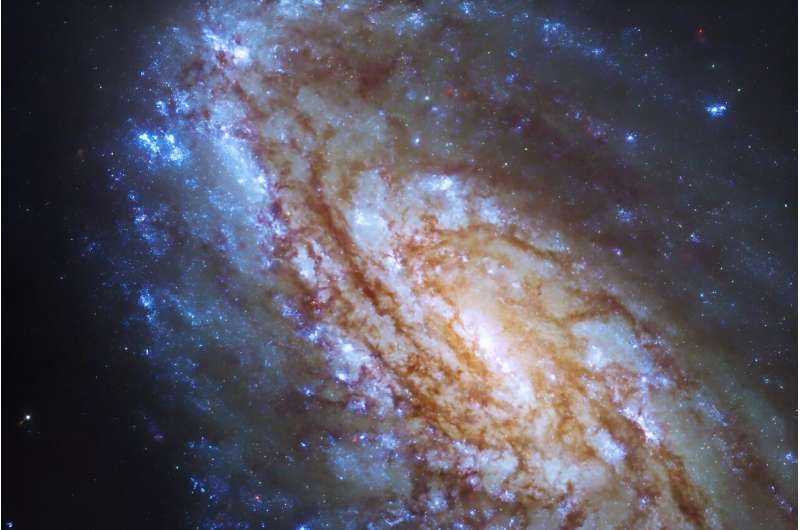This article has been reviewed according to Science X's editorial process and policies. Editors have highlighted the following attributes while ensuring the content's credibility:
fact-checked
peer-reviewed publication
trusted source
proofread
Galaxy clusters could be used as dark matter colliders to understand nature of invisible particles, say scientists

What is dark matter? Even for astrophysicists, it's a question that remains unanswered. These invisible particles make up most of the matter in the universe and about a quarter of the universe as a whole. They are thought to be the cosmic glue that binds the universe together, but we still don't know what kind of particle they are. Finding the answer to that question could provide us with an unprecedented understanding of the past, present and future of our known universe.
A study by astrophysicists at Northeastern University provides a potential new way of answering this age-old question. The research is published in Monthly Notices of the Royal Astronomical Society.
"Everything in the universe is a particle and a wave and a field, so the baseline [assumption] is dark matter must be a particle," says Jacqueline McCleary, an assistant professor of physics and author of the paper. "The question is what kind of a particle, as a particle is very vague."
The method laid out in the paper involves using merging groups of galaxies as giant natural dark matter colliders to observe what happens when dark matter interacts with itself. It attempts to overcome a major challenge in understanding the nature of dark matter: We can't do much on Earth.
Powerful particle accelerators like the Large Hadron Collider have helped scientists understand the nature of regular matter through high-energy particle collisions, but dark matter can't be manipulated in the same way.
Dark matter, like ordinary matter, occupies space, but it is essentially invisible to our eyes because light doesn't interact with it, McCleary says. However, it still has a measurable impact on the universe. Scientists believe there is a massive, web-like array of dark matter that exists throughout the universe, attracting most normal matter and even helping galaxies form and grow.
Instead of relying on Earth-bound equipment, these researchers turned to the cosmos for help. In this case, that involves observing galaxy clusters, groups of galaxies that have been drawn together by gravitational forces.
"Galaxy clusters are also dominated by dark matter," McCleary says. "Eighty to 90 percent of their mass is dark matter, and the more massive an object is, the faster the constituent dark matter particles will be moving. You're essentially studying very high-energy collisions."
Various theories have posited that dark matter is a photon, which carries electromagnetic force, an ultra, lightweight neutrino or even a tiny black hole. The current favored theory, McCleary says, is that dark matter is a WIMP, or weakly interacting massive particle. As the name indicates, these are hypothetical large, heavy, slow-moving particles that interact with each other and regular matter with weak force.
"Ground-based particle detection experiments have been operating for about 20 years and haven't turned up anything yet," McCleary says. "What this points us to is that dark matter probably isn't the most boring particle that we might have thought it was. It's probably not a pure WIMP or we would have found it by now. This has motivated us to look at other particle models for what dark matter could be."
The alternative model laid out in this paper posits that if these galaxy clusters, and their dark matter, collide with enough force, it should be possible to observe dark matter interacting with itself. McCleary and the other members of the research team modeled these interactions using hydrodynamic simulations, large-scale computer programs that can model the physical interactions between particles. In this case, that meant coding physical models for how dark matter, stars and gas would interact.
Watching dark matter collisions could help scientists determine some baseline particle characteristics that would help them hone their search for an answer to the dark matter question.
"If you can measure some self-interaction or if you can place some upper limit, you are ruling out or ruling in classes of particles that dark matter could be," McCleary says.
"If you measure some self-interaction, then you bring in another class of particles. You allow another class of theories. What this paper is also saying is that if you study a set of, say, 100 galaxy clusters that are merging, you have a chance of measuring the self-interaction of dark matter to some threshold."
"It seems counterintuitive at first because we always want a positive answer: What is it?" McCleary says. "But in this case, we're sort of forced to say, what isn't it? It is a process of elimination."
More information: Ellen L Sirks et al, Hydrodynamical simulations of merging galaxy clusters: giant dark matter particle colliders, powered by gravity, Monthly Notices of the Royal Astronomical Society (2024). DOI: 10.1093/mnras/stae1012
Journal information: Monthly Notices of the Royal Astronomical Society
Provided by Northeastern University
This story is republished courtesy of Northeastern Global News news.northeastern.edu.





















